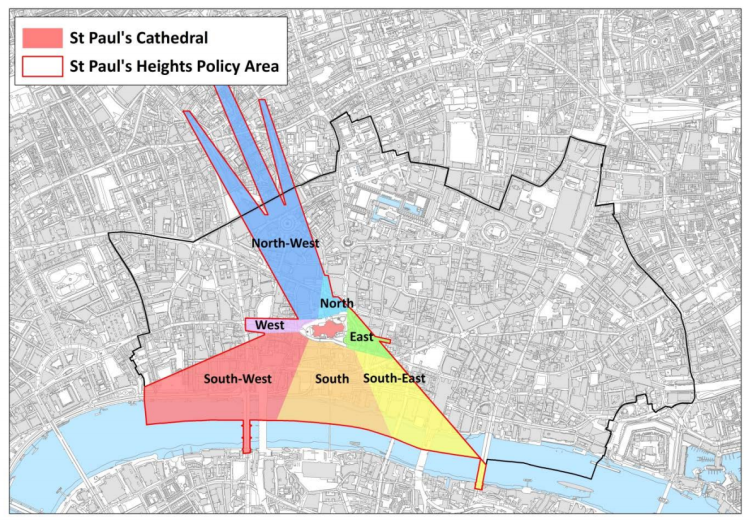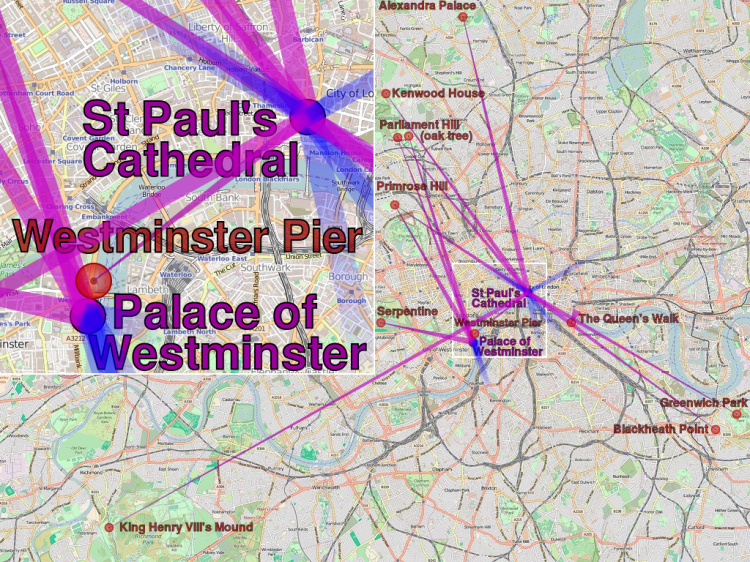Before continuing with my series on London canalscanals, I thought it best to write a brief post on something not very well known but that nonetheless has played an important role in the modern development of London, namely protected views.
London is far from the only city in Britain to have protected views, namely views that are considered so precious as to be out birthright to enjoy them unhindered by any man-man development. However with it being such a developed city and with such a wide number of ancient and iconic buildings from the Tower of London in the east past St Pauls and The Monument in the centre and through to Parliament further West, it is surely the most complex one.

Even today, after walking and driving round the streets of London on a daily basis for many years, I still find myself coming across a remarkable view of St Pauls Cathedral and it is almost certainly not by accident.
The London Building Acts of 1888 and 1894 ruled that architects should not be allowed to build structures in London higher than a fireman’s ladder — roughly 10 stories — to ensure the city’s finest landmarks, specifically St Paul’s Cathedral, were not overshadowed or obscured and this this decree was not amended in any way until 1956.
Amid pressure from developers to be allowed to build taller buildings, in 1938 the City of London Corporation introduced London’s
“protected views” system — to allow controlled construction that would not obscure views of St Paul’s Cathedral.
Architect W Godfrey Allen, an adviser to St Paul’s on the structure and setting of the cathedral, plotted multiple views of the iconic building from various vantage points in the city. Allen outlined eight “protected view corridors”. Allen’s proposals were accepted by the City of London Corporation, and implemented in 1938 — upheld by a “gentleman’s agreement” (an arrangement or understanding based upon the trust of all parties, rather than being legally binding) between the City Corporation and developers.
This voluntary approach proved to be surprisingly successful in protecting important views during the post-Second World War reconstruction of the City of London.
Similar rules protecting views of — and from — the 17th century
Monument to the Great Fire of London,
The Tower of London and Thames river vistas were implemented later in the 20th century.
London’s eight protected corridors radiate from: North London’s
Alexandra Palace; two vantage points in Hampstead Heath (Parliament Hill and the stately home
Kenwood House); Primrose Hill has another spot, 63 meters above sea level; Blackheath Point,
Greenwich Park‘s General Wolfe Statue; Westminster Pier; and
King Henry VIII’s mound — over 10 miles (16 km) away from St Paul’s Cathedral and only visible through a cultivated gap in a hedge that is said to be the hedge Henry VIII gazed through to receive a signal about whether his second wife Anne Boleyn had been executed.
Of all the buildings with a protected view, St Pauls is by far the most prominent and in part it is responsible for some of the unusual shapes of the near 21st century iconic skyscrapers, some of which were specifically designed the way they were so as not to impinge on the view of the cathedral.
But the effect of the cathedral on planning spreads way past the borders of the City: several “viewing corridors” exist to keep St Paul’s visible from other parts of London. The longest, and oldest, runs all the way to King Henry VIII’s Mount in Richmond – far enough way they’ve had to set up a telescope to enable you to see it as much more than a tiny dome-shaped blur. The view of the cathedral is also protected from Parliament and Primrose Hills, although the growth of the skyline around in over the last century means it barely stands out anyway.
In recent years, there’s been huge pressure to relax some of these rules given the increasing demand for ludicrously shaped tall buildings in London. 21st century mayor Ken Livingstone decreased the size of the “viewing cones” from 440m to 210m to much consternation but even if you do care about views, the argument could be made that a skyscraper can be as interesting to look at as a cathedral.
The Office for National Statistics recently says that London needs 844,000 more homes to meet the demands of its rising population. Critics claim that these ‘sightlines’ are preventing more than half a million homes being built in the city but there is no sign of the views losing their protected status and London is so huge, such towers could be built in many other places if it were really so desired but of course the profit from them would be much reduced which is probably what the complaints are about in the first place.


Priceless nuggets about a city so well known to many who don’t even live anywhere close 🙂
LikeLiked by 1 person
I’m glad you enjoyed it. I still find it fascinating that in a city with such a long and overwhelmingly capitalist culture, someone somewhere decided that there were views that are more important than money 🙂
LikeLiked by 1 person